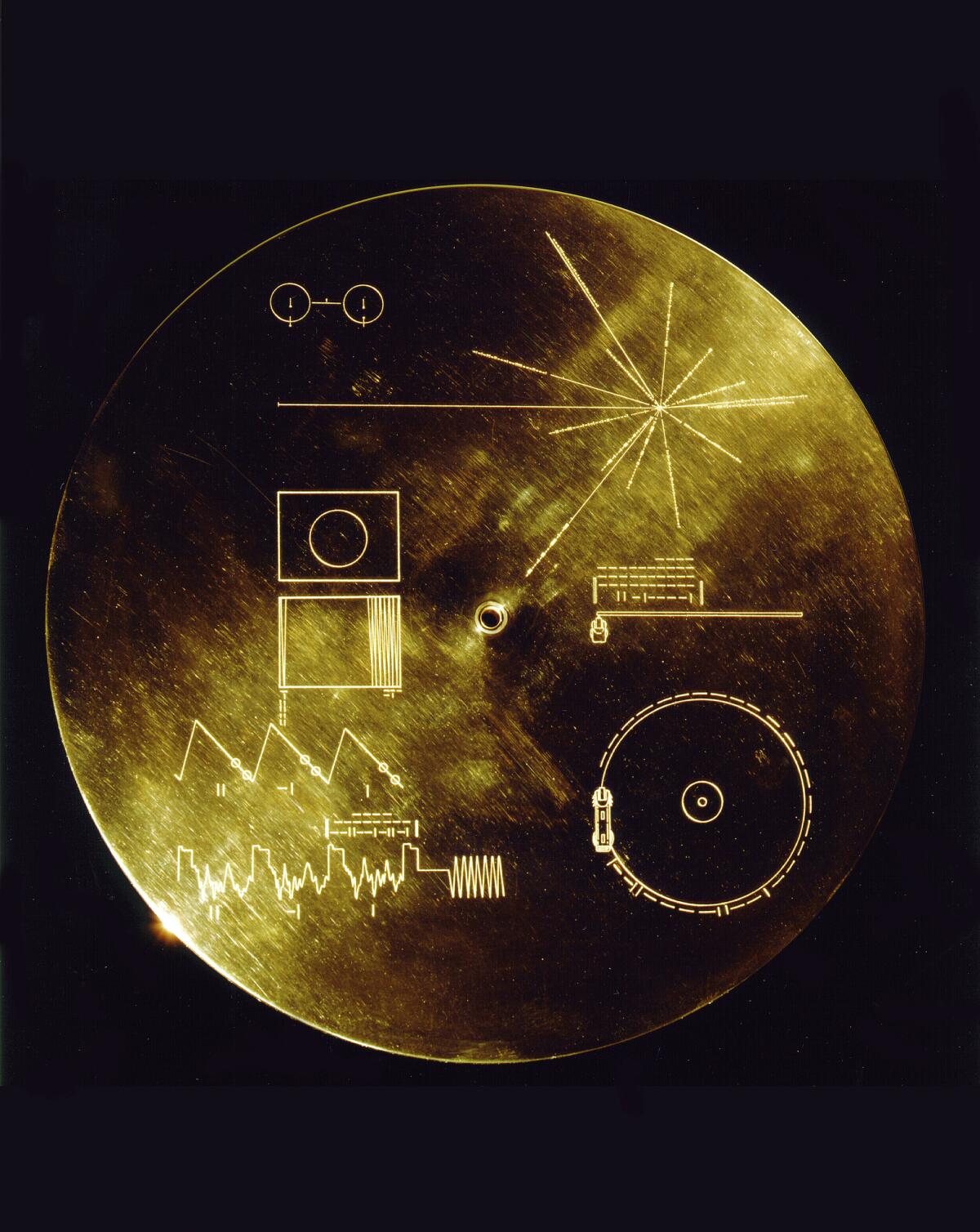Review: The Voyager spacecraft holds a golden record for aliens. ‘Vinyl Frontier’ tells why

- Share via
There was Ansel Adams’ photograph of the Golden Gate Bridge and an excerpt from Bach’s Brandenburg Concerto No. 2 in F Major. There were the sounds of crickets and frogs and greetings in English, Persian, French and Punjabi. Listen carefully and you can hear the surf — and the sounds of an elephant. It was not only a message in an interstellar bottle but also an intergalactic time capsule.
More than four decades ago, a team led by the famous Cornell astronomer Carl Sagan — himself a devout believer that we were not alone in the cosmos — created a message from Earth to be sent into the heavens on the Voyager spacecraft. This message, encoded on what is known as the Golden Record, is still hurtling through space, destination relatively unknown, recipient of the message completely unknown.
Book lovers! Sign up for the new L.A. Times Book Club for upcoming author events »
This effort was fueled on the slim chance that someone, some thing, some intelligent being somewhere, might encounter it, a 33-rpm record that was a record of our life, our times and our world. Here, metaphors soar like a NASA booster, but really, this record is the slenderest needle in the universe’s haystack. Music writer and self-described astronomy geek Jonathan Scott is our cheerful tour guide on this mission, and “The Vinyl Frontier” is our comprehensive and comprehensible itinerary.
It almost doesn’t matter whether this message is received somewhere beyond our solar system, though if it does, it is a very big deal. The very exercise of assembling this message was a pursuit worth undertaking — and worth sharing — in this brisk, estimable account, for the questions this effort raised are almost as important as the answers the team tried to discern:
What is the essence of our human civilization? What markers of our culture matter? How do, how should, humans adjudicate among the talismans of many different lands, ethnic groups, perspectives? Do humans even have the capacity to make these decisions? Do they even have the right?
And then there was one thing more: how to convey the (tentative) answers to these vital questions, and the product of these illuminating debates, to an “audience” whose powers of perception and means of processing information could not possibly be known?
“Science rubbed up against art to create a monument that will, in all probability, outlive us all,” Scott writes. “When we are dust, when the Sun dies, these two golden analogue discs, with heir handy accompanying stylus and instructions, will still be speeding off further into the cosmos.”
The group, not so much curators of our civilization as sorters of our life and times, wanted its message from Earth to include culture — art and music, for example — plus renderings of natural and man-made sounds from our earthly home. But before this record was completed, one of the great debates of the 20th century — maybe of all human history — unfolded: What to include and what not to include? This was not a mere parlor game, for the answer to this question might matter in space but surely would matter on Earth, where millions would evaluate the work of these evaluators and inevitably find them wanting.
The group set out three criteria for music: geographical diversity, economic diversity and what members called, dangerously, “good music.” There the bickering began. They eliminated Miles Davis’ “Summertime,” even though it was the product of a black musician playing the work of a white composer. They did include the “Prelude and Fugue F\from Bach’s Well-Tempered Clavier,” with a performance by Canada’s Glenn Gould.
That question was hard enough. Which agricultural scenes should be implanted in the record? Which manufacturing scenes? (And who says the recipients of this intergalactic aerogram had vision?) To display communications, Morse code was an easy choice. But what to say about the Earth itself?
Throughout this volume, Scott examines the debates and the choices and tells us how the members of this committee went out into the field (and actually once to a supermarket) to create the images they wanted. Said one team member: “I understood the record was an opportunity for us humans to look at ourselves and ask what’s essential about humanity.” That difficult question wasn’t humankind’s final exam. Let’s think of it as a midterm.
When it came to choosing which pop song to include, the finalists were “Roll Over Beethoven” and “Johnny B. Goode.” Sagan took the question to his Cornell class, which chose Chuck Berry. “Here Comes the Sun,” which had the advantage of a solar-system theme, didn’t make it because, though the Beatles were all for it, the holder of the copyright wasn’t. (That itself is an emblem of earthly culture.) Speaking of space puns, Jefferson Starship didn’t make it either.
This effort was agonizing; it expanded the perspectives — dare we say horizons? — of all concerned; it was creative. So far, the record hasn’t been played beyond the bounds of Earth. But it’s early. Right now, Scott tells us, Voyager 1 is heading in the general direction of the constellation Ophiuchus. “In about 40,000 years,” he writes, “it will come within 1.7 light years of AC+79 3888, a star in Ursa Minor.” Let’s hope that it checks back with us when it gets there. But I wouldn’t wait up for it tonight, or even tomorrow night.
::
“The Vinyl Frontier: The Story of the Voyager Golden Record”
Jonathan Scott
Bloomsbury Sigma: 288 pp., $28
Shribman is a Pulitzer Prize winner who for 16 years was executive editor of the Pittsburgh Post-Gazette.
More to Read
Sign up for our Book Club newsletter
Get the latest news, events and more from the Los Angeles Times Book Club, and help us get L.A. reading and talking.
You may occasionally receive promotional content from the Los Angeles Times.








